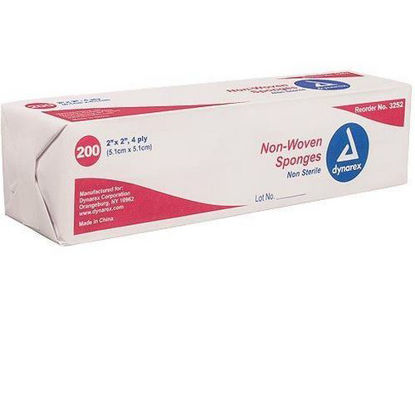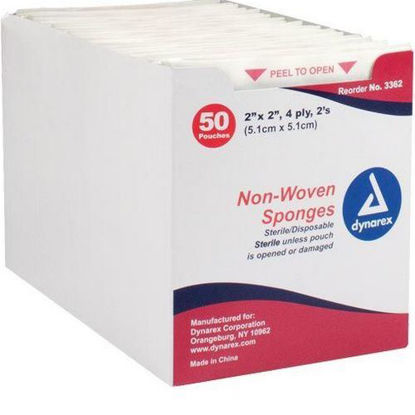- Brands
- Blog
- About Us
- Contact
- Daily Living Aids
- Catheters
- Compression Stockings & Socks
- Medical Cushions for Seating & Bedding
- Medical Incontinence Supplies
- Infection Control Supplies
- Ostomy Supplies
- Personal Care Medical Supplies
- Respiratory Care
- Wheelchairs & Accessories
- Wound Care Supplies
Non-Woven Gauze: Versatile Wound Care Supply
Non-woven gauze is a practical and efficient option for wound care needs. This guide has explored its uses, advantages, and considerations for effective utilization in medical settings.
What is Non-Woven Gauze?
Non-woven gauze is made from fibers that are bonded together mechanically, chemically, or thermally, rather than woven together like traditional gauze. This construction makes non-woven gauze highly absorbent and durable, with minimal linting.
What is Non-Woven Gauze Used For?
Non-woven gauze has various applications in wound care, including:
- Wound cleaning and debridement
- Applying topical medications or ointments
- Providing padding and protection to injured areas
- Securing dressings and bandages in place
Does Non-Woven Gauze Stick to Wounds?
Non-woven gauze typically does not adhere to wounds, making it an excellent choice for wound dressings and packing. Its non-adherent properties minimize trauma during dressing changes and promote patient comfort.
How to Use Non-Woven Gauze
When using non-woven gauze:
- Clean the wound with saline solution or antiseptic and pat it dry.
- Cut the non-woven gauze to the appropriate size, ensuring it covers the wound adequately.
- Apply any prescribed medications or ointments to the wound surface.
- Place the non-woven gauze over the wound, ensuring it overlaps the edges of the wound slightly.
- Secure the gauze in place with medical tape or a self-adherent bandage.
When to Use Non-Woven Gauze
Non-woven gauze is suitable for use in various medical settings, including hospitals, clinics, and home care environments. It is particularly useful for patients with sensitive skin or those requiring frequent dressing changes.
Woven vs Non-Woven Gauze
The primary difference between woven and non-woven gauze lies in their construction. Woven gauze is made by interlacing threads in a crisscross pattern, resulting in a fabric with visible pores. Non-woven gauze, on the other hand, is produced by bonding fibers together without weaving, creating a smoother and more uniform texture. Non-woven gauze offers superior absorbency, reduced linting, and enhanced conformability compared to woven gauze.
In summary, non-woven gauze is a versatile and essential component of wound care. Its unique properties make it suitable for various applications, from wound cleaning to dressing and bandaging. With its high absorbency and non-adherent nature, non-woven gauze offers comfort and effectiveness in managing different types of wounds.
Covidien Curity - Nonwoven All-Purpose Gauze Sponges
- 4 Ply
- Virtually lint free
- 40% heavier than imported brands
Covidien Curity - Wound Packing Strip
- 100% cotton
- Used for open wound healing
- Fine mesh gauze
- Ideal for wet to dry wound packing
Dynarex - Non-Sterile Non-woven Gauze Sponges
- Extremely absorbent
- Less linting than standard gauze
- Ideal for wound dressings, prepping, scrubbing, or general purpose cleansing
- 2" x 2" and 3" x 3": bag of 200, case of 20 bags (4000) 4" x 4": bag of 200, case of 10 bags (2000)
Dynarex - Sterile Non-woven Gauze Sponges
- Sterile
- 4-ply non-woven
- Extremely absorbent
- Less linting than standard gauze
- Ideal for wound dressings, prepping and scrubbing, general purpose cleansing
- 2" x 2": box of 50 packs (100), case of 30 boxes (3000)
- 3" x 3": box of 50 packs (100), case of 24 boxes (2400)
- 4" x 4": box of 25 packs (50), case of 24 boxes (1200)
Medline Avant - Non-Sterile Gauze Sponges with Non-Woven Formed Fabric
- Less lint than standard gauze sponges
- Non-woven four ply rayon/polyester blend
- Gauze sponge wound dressing is less likely to stick to wound
- Wound dressing for use in absorption, wicking, and wound release
Covidien Curity - Non-sterile Cover Sponges
- 4" x 4"
- Non woven gauze sponge
- Latex free
- Ideal for moderate to high exuding wounds
Covidien Curity - Non-woven Cover Sponges
- Designed for general use with heavy to moderate exuding wounds
- Cellulose wadding filling covered in non-woven fabric
- Economical wound covering
- Made in the USA
Covidien Dermacea - USP Type VII Gauze Sponges
- Meet USP Type VII requirements
- Nonwoven and nonsterile
- 4" x 4" gauze sponge
- Made from 100% cotton
- Use for a variety of wound applications
Non-Woven Gauze: Versatile Wound Care Supply
Non-woven gauze is a practical and efficient option for wound care needs. This guide has explored its uses, advantages, and considerations for effective utilization in medical settings.
What is Non-Woven Gauze?
Non-woven gauze is made from fibers that are bonded together mechanically, chemically, or thermally, rather than woven together like traditional gauze. This construction makes non-woven gauze highly absorbent and durable, with minimal linting.
What is Non-Woven Gauze Used For?
Non-woven gauze has various applications in wound care, including:
- Wound cleaning and debridement
- Applying topical medications or ointments
- Providing padding and protection to injured areas
- Securing dressings and bandages in place
Does Non-Woven Gauze Stick to Wounds?
Non-woven gauze typically does not adhere to wounds, making it an excellent choice for wound dressings and packing. Its non-adherent properties minimize trauma during dressing changes and promote patient comfort.
How to Use Non-Woven Gauze
When using non-woven gauze:
- Clean the wound with saline solution or antiseptic and pat it dry.
- Cut the non-woven gauze to the appropriate size, ensuring it covers the wound adequately.
- Apply any prescribed medications or ointments to the wound surface.
- Place the non-woven gauze over the wound, ensuring it overlaps the edges of the wound slightly.
- Secure the gauze in place with medical tape or a self-adherent bandage.
When to Use Non-Woven Gauze
Non-woven gauze is suitable for use in various medical settings, including hospitals, clinics, and home care environments. It is particularly useful for patients with sensitive skin or those requiring frequent dressing changes.
Woven vs Non-Woven Gauze
The primary difference between woven and non-woven gauze lies in their construction. Woven gauze is made by interlacing threads in a crisscross pattern, resulting in a fabric with visible pores. Non-woven gauze, on the other hand, is produced by bonding fibers together without weaving, creating a smoother and more uniform texture. Non-woven gauze offers superior absorbency, reduced linting, and enhanced conformability compared to woven gauze.
In summary, non-woven gauze is a versatile and essential component of wound care. Its unique properties make it suitable for various applications, from wound cleaning to dressing and bandaging. With its high absorbency and non-adherent nature, non-woven gauze offers comfort and effectiveness in managing different types of wounds.










